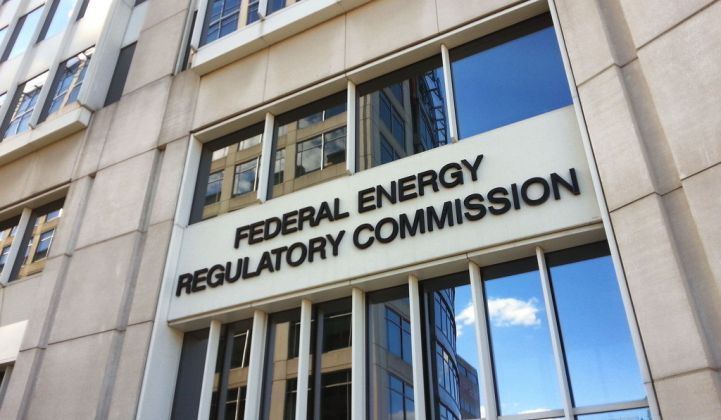The U.S. Senate confirmed James Danly to the Federal Energy Regulatory Commission on Thursday, stacking a third Republican against the lone Democrat on the board of a federal agency that has increasingly been seen as using its authority over interstate energy markets to privilege fossil fuels over renewables.
Danly, who will fill the seat left vacant by the death of Chairman Kevin McIntyre, graduated from law school in 2013 and worked as a corporate energy lawyer before he was named general counsel at FERC in 2017. His lack of experience in the industries he will now regulate has drawn sharp criticism from Senate Democrats, and his nomination last year was initially rejected by the Senate in January, before being sent back by the Trump administration last month.
Danly joins two other Republicans at FERC: Chairman Neil Chatterjee, a former aide to Senate Majority Leader Mitch McConnell, and Bernard McNamee, a Texas attorney for conservative groups who, as deputy general counsel for energy policy at the Department of Energy, helped craft a Trump administration proposal under which FERC would force utilities to buy power from coal-fired power plants as critical grid security assets — a proposal that FERC unanimously rejected in early 2018.
Thursday’s confirmation breaks the longstanding norm of “pairing” Republicans and Democrats at FERC, which normally has five members, so that no one party has dominance. The Trump administration has refused to take up the nomination put forth by Democrats to fill the seat left by Commissioner Cheryl LaFleur last year, leaving only one Democrat, Richard Glick, a former utility lobbyist and general counsel for the Democrats on the Senate Energy and Natural Resources Committee.
Still, Danly won confirmation in a 52-40 vote Thursday, with three Democratic senators — Joe Manchin of West Virginia, Kristen Sinema of Arizona and Doug Jones of Alabama — joining Republicans. Manchin, the ranking Democrat on the Senate Energy and Natural Resources Committee, said that after Danly he would not vote for another Republican nominee to replace McNamee unless a Democrat is also nominated.
Danly’s confirmation comes as fellow FERC Commissioner McNamee has announced plans to retire after his term ends in June, which would still leave FERC with a 2-1 Republican majority — unless the Trump administration allows a Democratic nominee to move forward. It would also maintain a quorum at FERC, which it lacked throughout much of 2017, leaving it unable to vote on key decisions for interstate electricity transmission and natural-gas projects.
Senator Maria Cantwell, D-Washington, missed Thursday’s vote, as she was working from home on doctor’s advice after one of her staff members was diagnosed with COVID-19 on Wednesday. But in a statement, Cantwell said she would have voted against Danly’s confirmation, adding that political balance is critical for FERC to ensure “just and reasonable rates” for all customers and to “continue to modernize to tackle and adapt to emerging threats like cyber-attacks and climate change.”
Energy industry groups, many of which have been exasperated by the under-staffing at FERC, reacted to Danly's confirmation with varying degrees of approval.
The American Council on Renewable Energy, which advocates for clean energy policies on behalf of its corporate members, congratulated Danly on his nomination but called for FERC to be restored to five members distributed between Republicans and Democrats. "We respectfully ask the President to nominate, and the Senate to confirm, two more commissioners on a bipartisan basis to fill the remaining Commission vacancies.”
FERC's recent decisions under fire
While less prominent than many other federal agencies, FERC's importance in the energy world is big, and some of its recent decisions have been highly controversial.
The 2-1 Republican majority since LaFleur’s departure has voted on a series of decisions expected by many to undercut renewables and direct money toward fossil-fuel-fired power plants.
FERC’s December order to mid-Atlantic grid operator PJM, for example, is expected to drive almost all new state-subsidized renewable energy — and potentially new energy efficiency and demand response as well as existing nuclear power plants — out of PJM's roughly $10-billion-per-year capacity market, the country’s biggest.
Chairman Chatterjee has justified the use of the minimum price offer rule (MOPR) as a means to “level the playing field” for all resources amid a rising tide of state incentives for clean energy that's “suppressing prices in capacity markets.”
The MOPR order, which is being contested by renewable energy and environmental groups and states with clean energy policies, is expected to direct hundreds of millions of dollars per year in increased energy bills to coal- and natural-gas-fired power plants, which already dominate its market for future grid capacity.
In a scathing dissent, Democrat Glick accused his fellow commissioners of “nullifying state policies” with the order by "making it very difficult for state-preferred resources to clear in the capacity market."
Illinois, which is crafting a bill that would mandate 100 percent clean energy, has laid plans to remove itself from PJM’s capacity market through a provision known as a "fixed resource requirement" in order to protect its existing nuclear power plants, and future renewable energy resources, from being shut out of revenues for providing grid reliability.
FERC also ruled 2-1 last month on a series of orders expected to restrict New York grid operator NYISO’s policy efforts to encourage energy storage and renewable energy in its capacity markets. FERC’s Republican majority has also upheld orders that have reduced renewable energy participation in New England grid operator ISO-NE’s capacity market.
FERC’s recent capacity market decisions have drawn intense criticism from Senate Democrats, states with clean energy goals and mandates, and even former FERC commissioners.




